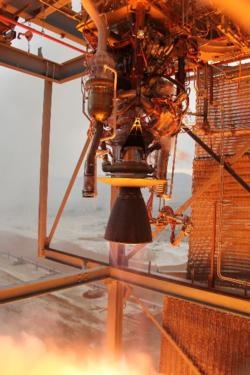Fri, Apr 17, 2015
Will Boost New Shepard Suborbital Flight
Blue Origin recently completed acceptance testing of its BE-3 rocket engine, the first new hydrogen engine to be developed in the United States in more than a decade. The 110,000-lbf BE-3 will power Blue Origin’s New Shepard suborbital system, and later, will be modified for upper stage applications.

"The BE-3 has now been fired for more than 30,000 seconds over the course of 450 tests,” said Jeff Bezos, Blue Origin founder. “We test, learn, refine and then test again to push our engines. The Blue Origin team did an outstanding job exploring the corners of what the BE-3 can do and soon we’ll put it to the ultimate test of flight.”
The BE-3 can be continuously throttled between 110,000-lbf and 20,000-lbf thrust, a key capability for vertical takeoff and vertical landing vehicles. The testing profile included multiple mission duty cycles, deep throttling and off-nominal test points.
“Liquid hydrogen is challenging, deep throttling is challenging and reusability is challenging," said Bezos. “This engine has all three. The rewards are highest performance, vertical landing even with a single-engine vehicle and low cost. And, as a future upper stage engine, hydrogen greatly increases payload capabilities.”
The BE-3 engine was designed and fabricated at Blue Origin’s design, development and production facility in Kent, Wash. Full-engine testing was conducted at the company’s facilities in West Texas, while earlier combustion chamber testing was completed at NASA’s Stennis Space Center in Mississippi.
The BE-3 is the third generation of Blue Origin-developed engines. The fourth-generation BE-4 uses liquid oxygen and liquefied natural gas (LNG) to produce 550,000-lbf thrust at sea level. Under development since 2012, the BE-4 provides the lowest cost and fastest production path to power the nation’s access to space. Selected by United Launch Alliance to serve as the primary propulsion provider for its Next Generation Launch System, Blue Origin is developing the BE-4 as an integrated part of America’s newest launch vehicle.
(Image provided by Blue Origin)
More News
Takeoff Roll The process whereby an aircraft is aligned with the runway centerline and the aircraft is moving with the intent to take off. For helicopters, this pertains to the act>[...]
“We’re proud of the hard work that went into receiving this validation, and it will be a welcome relief to our customers in the European Union. We couldn’t be mor>[...]
"Aircraft Spruce is pleased to announce the acquisition of the parts distribution operations of Wag-Aero. Wag-Aero was founded in the 1960’s by Dick and Bobbie Wagner in the >[...]
IDENT Feature The special feature in the Air Traffic Control Radar Beacon System (ATCRBS) equipment. It is used to immediately distinguish one displayed beacon target from other be>[...]
Aero Linx: Pararescue Air Force Pararescuemen, also known as PJs, are the only DoD elite combat forces specifically organized, trained, equipped, and postured to conduct full spect>[...]
 ANN's Daily Aero-Term (05.10.24): Takeoff Roll
ANN's Daily Aero-Term (05.10.24): Takeoff Roll Aero-News: Quote of the Day (05.10.24)
Aero-News: Quote of the Day (05.10.24) Aero-News: Quote of the Day (05.11.24)
Aero-News: Quote of the Day (05.11.24) ANN's Daily Aero-Term (05.11.24): IDENT Feature
ANN's Daily Aero-Term (05.11.24): IDENT Feature ANN's Daily Aero-Linx (05.11.24)
ANN's Daily Aero-Linx (05.11.24)



